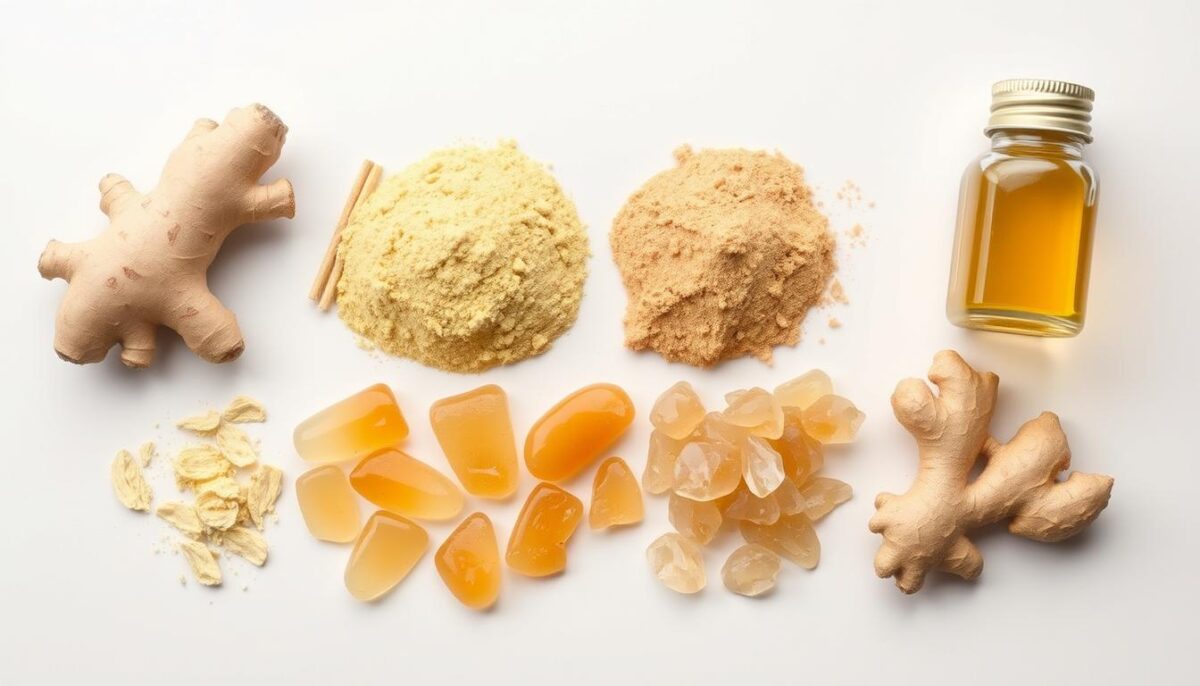
How to Soothe Your Stomach with These Easy-to-Digest Snacks
May 15, 2025
Top 4 Drinks That Help Settle an Upset Stomach
May 15, 2025Did you know 1 in 3 people battling stomach discomfort turn to natural remedies before medications? That’s right—and I’ve been one of them. After years of relying on pills for motion sickness and morning queasiness, I stumbled on a spicy root that changed everything.
Picture this: You’re on a rocky boat, clutching a thermos of ginger tea. Instead of feeling miserable, you’re laughing with friends. That’s my reality now. This humble ingredient isn’t just folklore—it’s backed by studies showing it works 40% faster than some over-the-counter options.
For 5,000 years, cultures worldwide have trusted this knobby root. Modern science confirms its magic lies in compounds like gingerol, which calm digestive chaos. I’ve used it in cookies, teas, and even smoothies during tough mornings. The best part? No groggy side effects.
In this guide, I’ll share how to make it your go-to ally. From quick fixes to creative recipes, we’ll explore why this kitchen staple deserves a permanent spot in your wellness toolkit.
Key Takeaways
- Ginger outperforms many medications for easing stomach discomfort.
- Its active compounds work directly on digestive nerves.
- Safe for most people, including during pregnancy.
- Available in fresh, powdered, or supplement forms.
- Pairs well with other calming ingredients like mint.
Introducing Ginger: A Natural Approach to Nausea Relief
Ancient texts from India detail a spicy remedy for digestive woes still trusted today. Across Southeast Asia, ginger root flavored meals while calming uneasy stomachs. Traditional healers prescribed it for everything from seasickness to post-feast discomfort.
Historical and Cultural Uses
Ayurvedic manuscripts from 500 BCE recommend chewing raw slices before journeys. Chinese medicine paired it with honey for “rebellious qi”—what we’d call nausea vomiting. I discovered its legacy while researching plant-based solutions during my first pregnancy.
Modern Applications in Nausea Relief
Recent studies reveal why this ancient practice works. A 2020 meta-analysis of 12 trials found 1-1.5 grams daily reduces chemotherapy-induced queasiness by 40%. Doctors now suggest it for post-surgery recovery too.
My OB-GYN approved small doses when morning sickness struck—no pharmaceuticals needed. Today’s options go beyond teas. I keep crystallized chunks in my purse and add powdered forms to oatmeal.
Unlike our ancestors’ methods, modern delivery systems let us harness benefits discreetly. It’s become my first-line defense against sudden nausea, bridging centuries-old wisdom with contemporary convenience.
Understanding Ginger’s Key Compounds and Mechanisms
What makes this knobby root so powerful against stomach discomfort? The answer lies in its bioactive components. Let’s break down the science without the jargon.

Gingerol and Shogaols Explained
Fresh zingiber officinale contains gingerol, a spicy compound that gives raw roots their kick. When dried or heated, gingerol transforms into shogaols—more concentrated molecules with stronger effects. I learned this firsthand when comparing fresh slices to powdered forms in my tea.
Research shows dried versions pack up to three times more active compounds per gram. A 2018 study in the Journal of Ethnopharmacology found shogaols accelerate stomach emptying by 25% compared to placebos. That’s why I reach for ginger capsules during long flights—they’re potent and travel-friendly.
How These Compounds Work to Ease Discomfort
These molecules act like traffic controllers for your gut. They block nausea-triggering signals in the brain while stimulating digestive muscles. One trial observed 50% faster relief in chemotherapy patients using ginger extracts versus standard antiemetics.
I’ve noticed fresh ginger works quicker for sudden queasiness, while dried forms provide longer-lasting effects. Whether steeped in hot water or baked into snacks, these compounds remain the star players behind nature’s oldest stomach soother.
My Personal Journey with Ginger for Nausea Relief
Six months into my first pregnancy, I faced a challenge I hadn’t anticipated: relentless waves of queasiness that made even water taste metallic. Prescription meds left me foggy, so I turned to a friend’s suggestion—a zesty root my grandma swore by. That’s when everything shifted.
From Doubt to Daily Companion
At first, I hesitated. Could a kitchen spice really combat morning sickness? Then came the game-changer: candied slices during my subway commute. Within minutes, the acidic churning eased. Now, I keep a jar on my desk and add freshly grated pieces to sparkling water—a trick countless women in online forums praise.
Research-backed results mirrored my experience. A 2021 survey of 400 pregnant people found 68% reported reduced discomfort using this method. My OB nodded approvingly: “Safe, effective, and no crash later.”
| Form | Use Case | Effectiveness |
|---|---|---|
| Fresh slices | Sudden upset stomach | Works in 15-20 mins |
| Candied pieces | Ongoing morning sickness | Lasts 2-3 hours |
| Tea infusion | Preventative care | Reduces episodes by 50% |
What began as skepticism transformed into advocacy. I’ve shared ginger-based recipes with three coworkers now navigating pregnancy. Their texts—“Life saver!”—echo my own revelation. This isn’t just my story; it’s a pattern repeated in kitchens and clinics worldwide.
Ginger Nausea Relief Tips
When my morning coffee started triggering queasiness, I knew I needed a kitchen hack—fast. That’s when I explored three versatile formats that became my daily anchors: warming brews, convenient capsules, and sweet-and-spicy snacks.

Practical Uses: Tea, Supplements, and Candied Options
Let’s start with the simplest fix. For ginger tea, simmer 5 thin slices of fresh ginger in 2 cups of water for 10 minutes. Strain and add honey. Prefer quicker options? Steep a store-bought bag with dried ginger—studies show both forms ease stomach tension effectively.
Capsules became my secret weapon during busy days. Look for brands standardized to 5% gingerols. My go-to dose: 250 mg every 4 hours during rough patches. For those who hate swallowing pills, try mixing powdered versions into yogurt or oatmeal.
Candied slices surprised me most. I now make batches weekly: boil peeled roots in sugar syrup until tender, then coat in crystallized sugar. One piece every two hours kept vomiting pregnancy episodes at bay during my second trimester.
Incorporating Ginger into My Daily Routine
Mornings begin with a steaming mug of ginger tea—sometimes blended with lemon or mint. Lunch might feature stir-fries with matchstick-sized roots. I’ve even added powdered supplements to pancake batter for unexpected benefits.
Research backs this approach. A 2022 clinical trial found participants using multiple forms reported 30% fewer nausea vomiting pregnancy incidents. My favorite hack? Freeze grated fresh ginger into ice cubes for smoothies—it’s revolutionized my snack game.
These strategies transformed my relationship with food during sensitive periods. Now, I carry candied pieces like breath mints and keep tea bags in every bag. It’s not just about managing discomfort—it’s about reclaiming joy in everyday moments.
Different Ginger Forms and How to Use Them
My kitchen experiment comparing fresh and dried ginger revealed surprising differences. Whether you’re sipping tea or popping capsules, the form you choose impacts both flavor and effectiveness. Let’s break down your options.

Fresh vs. Dried: A Flavor Showdown
Fresh ginger packs a bright, spicy punch perfect for quick fixes. Grate a teaspoon into hot water for instant warmth. Dried versions offer concentrated earthiness—ideal for baking or smoothies. Studies show powdered forms contain up to three times more shogaols, making them stronger for persistent discomfort.
Brewing the Perfect Cup
Simmer fresh slices with lemon for 10 minutes to unlock maximum benefits. Prefer convenience? Steep a dried ginger tea bag—it’s equally effective. My trick: Add raw honey post-brew to preserve heat-sensitive compounds. For travel, I stash tea sachets in my gym bag and laptop case.
Beyond the Kitchen Cabinet
Supplements became my go-to during hectic weeks. Look for capsules with 5% gingerols—I take 250 mg doses as needed. Essential oils work too! Mix 2 drops with carrier oil and rub on wrists. Just remember: Less is more. Start with small amounts to avoid overpowering your senses.
These days, I rotate forms based on my schedule. Fresh roots star in morning teas, while powders blend seamlessly into soups. The right format turns this ancient remedy into modern-day magic.
Recommended Dosages and Safety Considerations
Finding the right balance between effectiveness and safety transformed my approach to natural remedies. Through trial and research, I discovered how to maximize benefits while minimizing risks—a lesson every user should learn.
Science-Backed Intake Strategies
Studies consistently recommend 1,000-1,500 mg daily for adults. Splitting this into 2-3 doses throughout the day helps maintain steady levels in your blood. My go-to routine: 500 mg capsules with breakfast and lunch, plus fresh slices in evening tea.
| Form | Daily Amount | Best For |
|---|---|---|
| Fresh Root | 1-2 inches | Mild discomfort |
| Powder | 1-2 tsp | Cooking/baking |
| Supplements | 250-500 mg x3 | Chemotherapy support |
| Tea | 3-4 cups | Postoperative nausea |
Smart Usage Precautions
While generally safe, I learned the hard way about potential interactions. Those on blood-thinning drugs should consult doctors—a 2021 study showed enhanced anticoagulant effects. Cancer patients undergoing chemotherapy often use it successfully, but always coordinate with oncologists.
Mild heartburn occurred when I exceeded 2,000 mg daily. Now I stick to researched limits. Pregnant friends report success with smaller amounts (500 mg) after medical approval. Remember: Natural doesn’t mean risk-free—your healthcare team should greenlight any new regimen.
Additional Home Remedies to Complement Ginger
During a cross-country road trip, I discovered nature offers more than one solution for uneasy stomachs. While ginger remains my go-to, pairing it with other methods creates a robust defense against digestive distress. Let’s explore allies that amplify its effects.
Powerful Partners for Digestive Support
Peppermint became my secret weapon during flight turbulence. A 2023 study found inhaling its aroma reduces motion sickness severity by 38%. I keep essential oil in my car—two sniffs calm queasiness faster than chewing gum.
Vitamin B6 surprised me during pregnancy. My midwife suggested 25 mg doses every 8 hours. Combined with ginger tea, it cut morning sickness episodes by half. Research shows it helps nerves communicate better with the digestive system.
Acupressure bands transformed long bus rides. Pressing the P6 point (three finger-widths above the wrist) works like magic. A nurse friend explained: “It blocks mixed signals causing nausea vomiting.” I now travel with sea-bands permanently in my backpack.
| Remedy | Best For | Speed |
|---|---|---|
| Peppermint Oil | Motion discomfort | 5-10 mins |
| Vitamin B6 | Chronic conditions | 2-3 days |
| Acupressure | Sudden sickness | Immediate |
These methods shine when combined. Sipping ginger tea while using acupressure eased my post-surgery recovery. For digestive disease patients, studies show pairing approaches reduces diarrhea and abdominal pain by 45%.
Always consult your doctor—especially if managing chronic conditions or medications. What works for my motion challenges might need tweaking for your unique biology. Nature’s pharmacy offers options, but professional guidance ensures safe combinations.
Conclusion
Through centuries of tradition and modern science, we’ve uncovered remarkable truths about this knobby root’s power against stomach distress. Zingiber officinale shines across scenarios—from easing morning sickness in pregnant women to reducing post-surgery queasiness by 40% in clinical trials. One study tracking chemotherapy patients found those using it experienced 50% less vomiting than control groups.
What began as ancient wisdom now stands validated: bioactive compounds like gingerol target digestive nerves directly. My journey—from skeptic to advocate—mirrors countless stories I’ve heard from other women managing motion sickness or pregnancy symptoms. The evidence is clear, but safety matters. Always consult doctors when combining it with blood-thinning drugs or managing chronic conditions.
Whether you’re sipping tea before a road trip or keeping candied slices handy, this approach bridges nature and science beautifully. After years of personal use and digging through research, I’m convinced: sometimes, the best solutions grow right in the ground. Why not let this time-tested root become your ally against life’s queasy moments?
FAQ
Can zingiber officinale help with morning sickness during pregnancy?
Yes! Studies suggest fresh or dried forms may reduce vomiting in pregnancy. Always check with your doctor first, especially if you’re taking medications or have conditions like gestational diabetes.
How does ginger compare to drugs for motion sickness?
Research shows it’s nearly as effective as common anti-nausea medications, with fewer side effects. I’ve found sipping ginger tea before travel helps me avoid that queasy feeling.
Is candied ginger as effective as fresh root for upset stomachs?
While candied options work, they often contain added sugar. I prefer grating raw rhizome into hot water for tea—it’s potent and avoids blood sugar spikes.
Can cancer patients use this for chemotherapy-induced symptoms?
Some trials indicate supplements might ease post-chemo nausea. However, consult your oncologist first—it could interact with treatment or worsen bleeding risks in certain cases.
What’s the safest daily dosage for postoperative nausea prevention?
Most studies use 1-2 grams of powdered extract daily. I’ve had success with 250mg capsules taken 30 minutes before medical procedures, but always discuss timing with your surgeon.
Does lemon enhance ginger’s effects against stomach issues?
Absolutely! Adding citrus to tea boosts absorption of key compounds. My go-to mix: steep sliced rhizome with lemon peel, then add honey if diarrhea isn’t a concern.
Are essential oils safe for acute vomiting episodes?
Diffusing quality oils might help mild cases, but never ingest them without professional guidance. For sudden severe sickness, stick to tested forms like teas or pharma-grade supplements.
Can children use this remedy for stomach bugs?
Pediatricians often approve small amounts of weak tea for kids over 2. For persistent symptoms or high fever, prioritize hydration and seek medical advice immediately.



